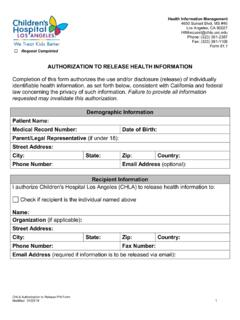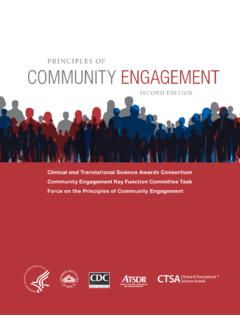Transcription of CHAPTER 1: NUTRITIONAL NEEDS OF INFANTS
1 I N F A N T N U T R I T I O N A N D F E E D I N G 11 IntroductionGood nutrition is essential for the growth and development that occurs during an infant s first year of life. When developing INFANTS are fed the appropriate types and amounts of foods, their health is promoted. Positive and supportive feeding attitudes and techniques demonstrated by the caregiver help INFANTS develop healthy attitudes toward foods, themselves, and the first year, many physiological changes occur that allow INFANTS to consume foods of varying composition and texture.
2 As an infant s mouth, tongue, and digestive tract mature, the infant shifts from being able to only suckle, swallow, and take in liquid foods, such as breast milk or infant formula, to being able to chew and receive a wide variety of complementary foods. See CHAPTER 5, page 101, for more information regarding complementary foods. At the same time, INFANTS progress from needing to be fed to feeding themselves. As INFANTS mature, their food and feeding patterns must continually proper growth and development, an infant must obtain an adequate amount of essential nutrients by consuming appropriate quantities and types of foods.
3 During infancy, a period of rapid growth, nutrient requirements per pound of body weight are proportionally higher than at any other time in the life cycle. Although there are many nutrients known to be needed by humans, requirements have been estimated for only a limited number of CHAPTER includes sections on nutrition assessment, the Dietary Reference Intakes (DRIs), and background information on important nutrients needed during infancy. Counseling points that relate to the information presented in this CHAPTER are found in CHAPTER 8, pages 157 AssessmentTo determine an infant s NUTRITIONAL NEEDS and develop a nutrition care plan, an accurate assessment of the infant s NUTRITIONAL status must be performed.
4 The nutrition assessment provides the nutritionist or health counselor with important feeding practices and other information pertinent to an infant s health. Nutrition education sessions can then be designed to encourage positive, appropriate feeding practices and, if necessary, recommend strategies to correct inappropriate practices. By communicating periodically with a caregiver about an infant s NUTRITIONAL NEEDS in the first year of life, better care for the infant is assessment should include an examination of:Health and medical information Information gathered through chart review, caregiver interview, health care provider referral form(s), or other sources that may include history of chronic or acute illnesses or medical conditions, birth history, developmental disabilities, a clinical assessment identifying signs of NUTRITIONAL deficiencies, and other pertinent information ( immunization record).
5 1, 2 Dietary intake data: 1, 3 Feeding history Eating behaviors, feeding techniques, feeding problems, and environment; Appetite and intake Usual appetite, factors affecting intake such as preferences, allergies, intolerances, chewing/swallowing problems, feeding skills; Diet history Breastfed and/or infant formula-fed; frequency and duration of breastfeeding; frequency and amount of infant formula or complementary foods fed; age at introduction of complementary foods; variety of complementary foods provided; vitamin/mineral or other CHAPTER 1: NUTRITIONAL NEEDS OF INFANTS12 INFANT NUTRITION AND FEEDINGI N F A N T N U T R I T I O N A N D F E E D I N G 13supplements given; and problems such as vomiting, diarrhea, constipation, or colic.
6 And Socioeconomic background Primary and other caregivers, food preparation and storage facilities, use of supplemental feeding and financial assistance programs, access to health care, and ethnic and/or cultural influences on the Anthropometric Data Anthropometric measurements, , weight for age, length for age, weight for length, and head circumference for age;1 and Biochemical Data Data used to diagnose or confirm NUTRITIONAL deficiencies or excesses;1,4 in the WIC Program, hemoglobin, hematocrit, or other hematological tests are performed to screen for iron deficiency Reference Intakes (DRIs) The Dietary Reference Intakes (DRIs), developed by the Institute of Medicine s food and Nutrition Board, are four nutrient-based reference values intended for planning and assessing diets.
7 They include the Estimated Average Requirement (EAR), the Recommended Dietary Allowance (RDA), the Adequate Intake (AI), and the Tolerable Upper Intake Level (UL).5 Recommendations for feeding INFANTS , from infant formula to complementary foods, are based primarily on the DRIs. The DRIs for INFANTS are based on the nutrient content of foods consumed by healthy INFANTS with normal growth patterns, the nutrient content of breast milk, investigative research, and metabolic studies. It is difficult to define precise nutrient requirements applicable to all INFANTS because each infant is unique.
8 INFANTS differ in the amount of nutrients ingested and stored, body composition, growth rates, and physical activity levels. Also INFANTS with medical problems or special NUTRITIONAL NEEDS (such as metabolic disorders, chronic diseases, injuries, premature birth, birth defects, other medical conditions, or being on drug therapies) may have different NUTRITIONAL NEEDS than healthy INFANTS . The DRIs for vitamins, minerals, and protein are set at levels thought to be high enough to meet the nutrient NEEDS of most healthy INFANTS , while energy allowances, referred to as Estimated Energy Requirement (EER), are based on average requirements for INFANTS .
9 See page 15 for more information regarding EER. See Appendix A, pages 180 182, for a complete table of DRIs for INFANTS . Important NutrientsThe following sections include information on the food sources, functions, and concerns regarding major nutrients and nutrients considered to be of public health significance to INFANTS in the United States. For additional information on the function, deficiency and toxicity symptoms, and major food sources of the nutrients discussed below, as well as EAR is the median usual intake that is estimated to meet the requirement of half of the healthy population for age and gender.
10 At this level of intake, half the individuals will have their nutrient NEEDS met. The EAR is used to establish the RDA and evaluate the diet of a is the average dietary intake level sufficient to meet the nutrient requirement of nearly all (97 98 percent) healthy individuals. If there is not enough scientific evidence to establish an EAR and set the RDA, an AI is represents an approximation of intake by a group of healthy individuals maintaining a defined NUTRITIONAL status. It is a value set as a goal for individual intake of nutrients that do not have a is the highest level of ongoing daily intake of a nutrient that is estimated to pose no risk in the majority of the population.


